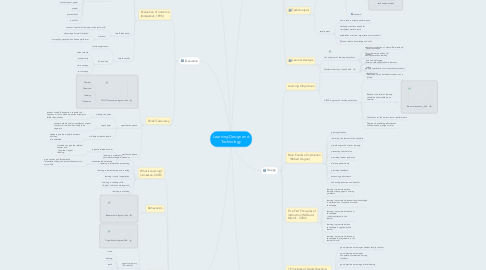
1. Implementation
1.1. Prepare a checklist of course objectives
1.1.1. facilitator training
1.1.2. learner training
1.2. Document timing of topic presented
1.2.1. Gantt chart
1.3. Observe the exchange of ideas and the communication between the instructor and learners
1.3.1. reaction of the learner
1.3.2. documenting ideas
1.3.3. improve the skills and experience
1.4. Verify the appropriate order of topic (link:
2. Evaluation
2.1. Evaluation of outcome (Kirkpatrick, 1998)
2.1.1. level1--reaction
2.1.1.1. content:customer satisfaction
2.1.1.2. surveys to collect data
2.1.2. level2--learning
2.1.2.1. content:knowledge and skills
2.1.2.2. measurement method
2.1.2.2.1. short-form test
2.1.2.2.2. short answer test
2.1.2.2.3. essay
2.1.2.2.4. performance test
2.1.2.2.5. written report, paper
2.1.2.2.6. project
2.1.2.2.7. presentation
2.1.2.2.8. portfolio
2.1.3. level3--behaviour
2.1.3.1. content: transfer of learning to the real world
2.1.3.2. method
2.1.3.2.1. observe performer first-hand
2.1.3.2.2. survey key people who observe performer
2.1.4. level4--results
2.1.4.1. match expectation
2.1.4.2. bottom line
2.1.4.2.1. sales volume
2.1.4.2.2. productivity
2.1.4.2.3. time savings
2.1.4.2.4. cost savings
2.2. SOLO Taxonomy
2.2.1. SOLO Taxonomy diagram (link:
2.2.1.1. Structure
2.2.1.2. Observed
2.2.1.3. Learning
2.2.1.4. Outcomes
2.2.2. quantitative phase
2.2.2.1. missing the point
2.2.2.1.1. student avoids the question, repeats the question or fail to make a genuine attempt to tackle the question
2.2.2.2. single point
2.2.2.2.1. answer based on only one relevant aspect, conclusion is limited and likely to be dogmatic
2.2.2.3. multiple unrelated points
2.2.2.3.1. students give the multiple answers but they are unrelated
2.2.3. qualitative phase
2.2.3.1. logically related answer
2.2.3.1.1. students can give the related answer and show their logical thinking
2.2.3.2. unanticipated extension
2.2.3.2.1. give answer, and illustrate the interrelationships, and extent the answer to more field
3. Learning Thoery
3.1. What is learning? (Jonassen, 2003)
3.1.1. learning is a relatively permanent change in behavior
3.1.2. learning is information processing
3.1.3. learning is remembering and reading
3.1.4. learning is social negotiation
3.1.5. learning is thinking skills (logical, critical, and pragmatic)
3.1.6. learning is activiting
3.2. Behavorism
3.2.1. Behavorism diagram (link:
3.3. Cognitivism
3.3.1. Cognitivism diagram (link:
3.3.2. sensory memory (0.5 second)
3.3.2.1. vision
3.3.2.2. hearing
3.3.2.3. touch
3.3.2.4. smell
3.3.2.5. taste
3.3.3. short-term memory
3.3.3.1. 20-30 seconds
3.3.3.2. limited capacity: 7items of information
3.3.4. attention
3.3.4.1. size
3.3.4.2. intensity
3.3.4.3. novelty
3.3.4.4. emotion
3.3.4.5. personal significant
3.4. Constructivism
3.4.1. definition
3.4.1.1. Knowledge construction is a process that learners build their knowledge building and improve their understanding when they interact with outsides circumstance.
3.4.2. type of constructivism
3.4.2.1. personal constructivism
3.4.2.2. social constructivism
3.4.2.3. mixture constructivism
3.4.3. learning roles
3.4.3.1. teachers
3.4.3.1.1. supporter :provide guidence
3.4.3.2. students
3.4.3.2.1. participant: self-directed
3.4.4. condition for learning
3.4.4.1. embed learning in relevant and realistic settings
3.4.4.2. provide for social negotiation
3.4.4.3. encourage ownership in learning
3.4.4.4. nurture self-reflection of knowledge construction
4. Analyze
4.1. Need Assessment (NA)
4.1.1. performance discrepancy =optimal-actuals
4.1.1.1. optimal is what people want to do
4.1.1.2. actual is what people currently do
4.1.2. purpose of need assessment
4.1.2.1. seeking potential trainees' opinions and feelings about problems
4.1.2.2. seeking causes of problems
4.1.2.3. seeking solutions of issues
4.1.3. source of NA data
4.1.3.1. larger constituency
4.1.3.2. policy maker
4.1.3.3. experts
4.1.3.4. manager
4.1.3.5. senior staff
4.1.3.6. audience
4.1.4. identify problem causes(link:
4.1.4.1. can't do
4.1.4.1.1. lack of required skill & knowledge
4.1.4.2. won't do
4.1.4.2.1. he know how to do but unwellingness
4.1.4.3. espoused theory
4.1.4.3.1. what someone say that they would do in a certain situation
4.1.4.4. theory-in-use
4.1.4.4.1. what they actually do in fact
4.1.5. propose possible solution
4.1.5.1. Mager & Pipe's flowchart (link:
4.2. Task Analysis
4.2.1. hierarchical task diagram
4.2.1.1. task
4.2.1.2. subtask
4.2.1.2.1. task analysis tabel
4.2.1.3. standard
4.2.2. requirement
4.2.2.1. how a task is actually performance
4.2.2.2. clarifying condition needs for competent performance
4.2.2.3. establishes minimum expectations or standard
4.2.2.4. need relative knowledge and skiis
4.3. Learner Analysis
4.3.1. Maslow hierarchy of needs (link:
4.3.1.1. self-actualization
4.3.1.2. esteem
4.3.1.3. love and belonging
4.3.1.4. safety
4.3.1.5. physiological
5. Design
5.1. Learning Objectives
5.1.1. the character of learning objectives
5.1.1.1. clear communication of what will be learned
5.1.1.2. inform learner how they will demonstrate their learning
5.1.1.3. communicate expectation to learners
5.1.1.4. provide specification for instructional products
5.1.2. ABCD approach of writing objectives
5.1.2.1. Audience: for an individual student, not a group
5.1.2.2. Behavior: the level of learning should be observable by an outsider
5.1.2.2.1. Bloom's taxonomy (link:
5.1.2.3. Conditions: at the time of test or performance
5.1.2.4. Degree: observable performances usually require a judge or rater
5.2. Nine Events of Instruction (Robert Gagne)
5.2.1. gaining attention
5.2.2. informing the learner of the objective
5.2.3. stimulating recall of prior learning
5.2.4. presenting the stimulus
5.2.5. providing learner guidance
5.2.6. eliciting performance
5.2.7. providing feedback
5.2.8. assessing performance
5.2.9. enhancing retention and transfer
5.3. Five First Principles of Instruction (M.David Merrill,2002)
5.3.1. learning is promoted when learners are engaged in solving problems
5.3.2. learning is promoted when existing knowledge is activated as a foundation for new knowledge
5.3.3. learning is promoted when new knowledge is demonstrated to the learner
5.3.4. learning is promoted when knowledge is applied by the learner
5.3.5. learning is promoted when new knowledge is integrated into the learner's world
5.4. 7 Principles of Good Teaching (Chickering & Gamson, 1987)
5.4.1. good practice encourages student-faculty contact
5.4.2. good practice encourages cooperation/interaction among students
5.4.3. good practice encourage active learning
5.4.4. good practice give prompt feedback
5.4.5. good practice emphasizes time on task
5.4.6. good practice communicates high expectations
5.4.7. good practice respects diverse talents and ways of learning
6. Development
6.1. Develop Instructional Materials
6.1.1. printed materials
6.1.1.1. advertisement material
6.1.1.2. learning material
6.1.2. multimedia software package
6.1.2.1. video
6.1.2.2. audio
6.1.2.3. words
6.1.2.4. image
6.1.3. set up the learning management system
6.2. Set the Standard of the Instructional Materials
6.2.1. cognitive load theory of multimedia learning
6.2.2. Co-existed
6.2.3. present on the same screen
6.2.4. redundancy
6.2.5. signaling
6.2.6. own pace of learners
6.2.7. interactive
6.3. Factors
6.3.1. time
6.3.1.1. forgetfulness (link:
6.3.2. human resources
6.3.2.1. professional knowledge
6.3.2.2. professional skill
6.3.2.2.1. TPCK MODEL (link:
6.3.2.3. attitude
6.3.3. equipment
6.3.3.1. hardware
6.3.3.2. software
